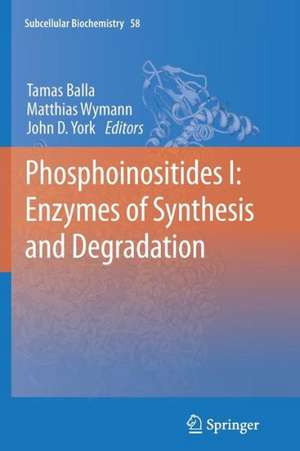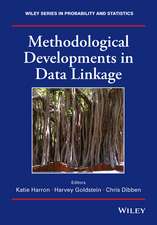Phosphoinositides I: Enzymes of Synthesis and Degradation: Subcellular Biochemistry, cartea 58
Editat de Tamas Balla, Matthias Wymann, John D. Yorken Limba Engleză Paperback – 16 apr 2014
| Toate formatele și edițiile | Preț | Express |
|---|---|---|
| Paperback (1) | 1098.48 lei 43-57 zile | |
| SPRINGER NETHERLANDS – 16 apr 2014 | 1098.48 lei 43-57 zile | |
| Hardback (1) | 1103.95 lei 43-57 zile | |
| SPRINGER NETHERLANDS – 14 mar 2012 | 1103.95 lei 43-57 zile |
Din seria Subcellular Biochemistry
- 18%
 Preț: 948.79 lei
Preț: 948.79 lei - 5%
 Preț: 1456.88 lei
Preț: 1456.88 lei - 18%
 Preț: 1373.84 lei
Preț: 1373.84 lei - 18%
 Preț: 1243.78 lei
Preț: 1243.78 lei - 18%
 Preț: 2098.81 lei
Preț: 2098.81 lei - 18%
 Preț: 1122.10 lei
Preț: 1122.10 lei - 5%
 Preț: 1160.63 lei
Preț: 1160.63 lei - 18%
 Preț: 1396.26 lei
Preț: 1396.26 lei - 18%
 Preț: 1114.96 lei
Preț: 1114.96 lei - 18%
 Preț: 1224.68 lei
Preț: 1224.68 lei - 18%
 Preț: 951.29 lei
Preț: 951.29 lei - 18%
 Preț: 1227.99 lei
Preț: 1227.99 lei -
 Preț: 398.15 lei
Preț: 398.15 lei -
 Preț: 399.88 lei
Preț: 399.88 lei - 18%
 Preț: 1231.47 lei
Preț: 1231.47 lei - 18%
 Preț: 1230.35 lei
Preț: 1230.35 lei -
 Preț: 392.60 lei
Preț: 392.60 lei - 18%
 Preț: 1231.47 lei
Preț: 1231.47 lei - 15%
 Preț: 638.76 lei
Preț: 638.76 lei - 5%
 Preț: 656.26 lei
Preț: 656.26 lei -
 Preț: 389.49 lei
Preț: 389.49 lei - 5%
 Preț: 659.19 lei
Preț: 659.19 lei -
 Preț: 392.37 lei
Preț: 392.37 lei - 5%
 Preț: 662.09 lei
Preț: 662.09 lei -
 Preț: 395.09 lei
Preț: 395.09 lei - 5%
 Preț: 667.99 lei
Preț: 667.99 lei -
 Preț: 400.47 lei
Preț: 400.47 lei - 18%
 Preț: 1224.54 lei
Preț: 1224.54 lei - 15%
 Preț: 647.73 lei
Preț: 647.73 lei - 15%
 Preț: 646.75 lei
Preț: 646.75 lei - 5%
 Preț: 662.30 lei
Preț: 662.30 lei -
 Preț: 395.25 lei
Preț: 395.25 lei - 18%
 Preț: 1230.21 lei
Preț: 1230.21 lei - 18%
 Preț: 1231.95 lei
Preț: 1231.95 lei - 18%
 Preț: 964.54 lei
Preț: 964.54 lei
Preț: 1098.48 lei
Preț vechi: 1156.29 lei
-5% Nou
Puncte Express: 1648
Preț estimativ în valută:
210.20€ • 220.02$ • 174.95£
210.20€ • 220.02$ • 174.95£
Carte tipărită la comandă
Livrare economică 31 martie-14 aprilie
Preluare comenzi: 021 569.72.76
Specificații
ISBN-13: 9789401781572
ISBN-10: 9401781575
Pagini: 372
Ilustrații: XVI, 356 p.
Dimensiuni: 155 x 235 x 20 mm
Greutate: 0.52 kg
Ediția:2012
Editura: SPRINGER NETHERLANDS
Colecția Springer
Seria Subcellular Biochemistry
Locul publicării:Dordrecht, Netherlands
ISBN-10: 9401781575
Pagini: 372
Ilustrații: XVI, 356 p.
Dimensiuni: 155 x 235 x 20 mm
Greutate: 0.52 kg
Ediția:2012
Editura: SPRINGER NETHERLANDS
Colecția Springer
Seria Subcellular Biochemistry
Locul publicării:Dordrecht, Netherlands
Public țintă
ResearchCuprins
1. The Phosphatidylinositol 4-kinases: Don’t Call it a Comeback.- 2. PIP kinases from the cell membrane to the nucleus.- 3. The Phospholipase C Isozymes and Their Regulation.- 4. Phosphoinositide 3-Kinases – A Historical Perspective.- 5. PI 3-kinases – drug targets in inflammation and cancer.- 6. Phosphoinositide 3-kinases in health and disease.- 7. Phosphoinositide phosphatases: just as important as the kinases.- 8. The PTEN and myobubularin phosphoinositide 3-phosphatases: linking lipid signalling to human disease.
Textul de pe ultima copertă
Phosphoinositides play a major role in cellular signaling and membrane organization. During the last three decades we have learned that enzymes turning over phosphoinositides control vital physiological processes and are involved in the initiation and progression of cancer, inflammation, neurodegenerative, cardiovascular, metabolic disease and more. In two volumes, this book elucidates the crucial mechanisms that control the dynamics of phosphoinositide conversion. Starting out from phosphatidylinositol, a chain of lipid kinases collaborates to generate the oncogenic lipid phosphatidylinositol(3,4,5)-trisphosphate. For every phosphate group added, there are specific lipid kinases – and phosphatases to remove it. Additionally, phospholipases can cleave off the inositol head group and generate poly-phosphoinositols, which act as soluble signals in the cytosol. Volume I untangles the web of these enzymes and their products, and relates them to function in health and disease. Phosphoinositide 3-kinases and 3-phosphatases have received a special focus in volume I, and recent therapeutic developments in human disease are presented along with a historical perspective illustrating the impressive progress in the field.
Volume II extends into the role of phosphoinositides in membrane organization and vesicular traffic. Endocytosis and exocytosis are modulated by phosphoinositides, which determine the fate and activity of integral membrane proteins. Phosphatidylinositol(4,5)-bisphosphate is a prominent flag in the plasma membrane, while phosphatidylinositol-3-phosphate decorates early endosomes. The Golgi apparatus is rich in phosphatidylinositol-4-phosphate, stressed cells increase phosphatidylinositol(3,5)-bisphosphate, and the nucleus has a phosphoinositide metabolism of its own. Phosphoinositide-dependent signaling cascades and the spatial organization of distinct phosphoinositide species are required in organelle function, fission and fusion, membrane channel regulation, cytoskeletal rearrangements, adhesion processes, and thus orchestrate complex cellular responses including growth, proliferation, differentiation, cell motility, and cell polarization.
The two volumes on “Phosphoinositides” provide a concise overview of the latest developments in the field of phosphoinositide hemostasis and function, and provide introductory background and extensions into unexplored territory.
Volume II extends into the role of phosphoinositides in membrane organization and vesicular traffic. Endocytosis and exocytosis are modulated by phosphoinositides, which determine the fate and activity of integral membrane proteins. Phosphatidylinositol(4,5)-bisphosphate is a prominent flag in the plasma membrane, while phosphatidylinositol-3-phosphate decorates early endosomes. The Golgi apparatus is rich in phosphatidylinositol-4-phosphate, stressed cells increase phosphatidylinositol(3,5)-bisphosphate, and the nucleus has a phosphoinositide metabolism of its own. Phosphoinositide-dependent signaling cascades and the spatial organization of distinct phosphoinositide species are required in organelle function, fission and fusion, membrane channel regulation, cytoskeletal rearrangements, adhesion processes, and thus orchestrate complex cellular responses including growth, proliferation, differentiation, cell motility, and cell polarization.
The two volumes on “Phosphoinositides” provide a concise overview of the latest developments in the field of phosphoinositide hemostasis and function, and provide introductory background and extensions into unexplored territory.
Caracteristici
In depth discussion of the state of the art of phosphoinositide research Experts in the field discussing the 'hot' topics in phosphoinositide research A volume dedicated to the enzymes involved in the synthesis and degradation of phosphoinositides Includes supplementary material: sn.pub/extras











